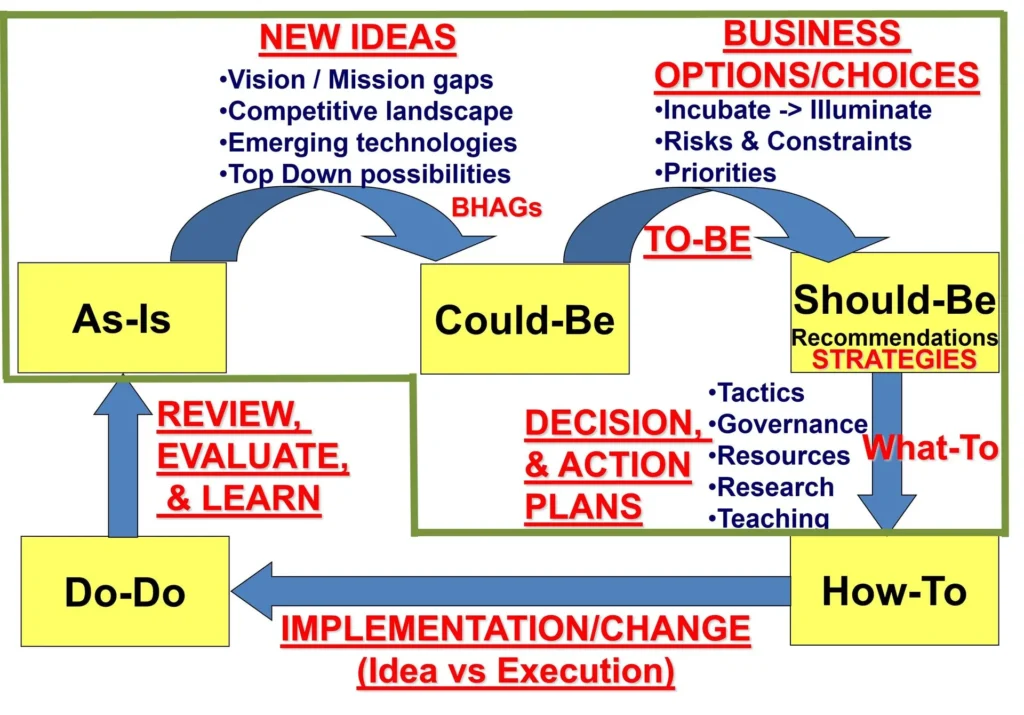This 4-course Certificate is designed:


It begins with identifying new ideas such as vision gaps, emerging technologies, and market opportunities, which are explored in the “Could-Be” phase. These ideas evolve into business options and strategies in the “Should-Be” stage, where key decisions are shaped by risk analysis and prioritization. The “How-To” stage defines actionable steps, involving tactics, governance, and resource planning. Execution occurs in the “Do-Do” phase, supported by strong implementation and change management. Finally, outcomes are reviewed in the “Review, Evaluate, & Learn” phase, feeding insights back into the cycle for continuous improvement. This process ensures a balance between ideation and execution, enabling organizations to adapt and lead effectively in dynamic environments.

As firms engage in the digital transformation and focus their investments in leveraging information technology for competitive advantage and performance improvements, it is essential to understand how to effectively and efficiently manage their information technology resources. There are numerous choices to be made about managing IT resources and it is essential to ensure IT and non-IT executives across the firm work in harmony.
Experience has made it clear that firms need well-thought out organizational structures, skills, processes, and decision rights to ensure that the decisions about how to leverage IT investments are well thought out and integrated across the enterprise. This course will help candidates understand the fundamental decisions related to the management of IT resources and the types of organizational structures, sourcing, governance, and processes that will help effectively and efficiently attain value to the enterprise. It concentrates on developing the candidates’ competency in current/emerging issues in creating and coordinating the key activities necessary to manage the day-to-day tactical and operational IT functions of an enterprise, as IT becomes ingrained in all aspects of the business.
Topics include:
This course addresses the strategic responsibilities and roles of the CIO. It focuses on devising an enterprise strategy for gaining and sustaining competitive advantage through the use of Information Technology and the development and implementation of policies and strategies to achieve organizational goals. The effective definition and use of information systems that enrich the strategic, operational and administrative needs throughout the organization will also be addressed. Approaches to managing the information systems function in organizations and ensuring that information systems strategies and business strategies are integrated will be the focus of the course.
Topics include:
IT organizations must be able to leverage new technologies. This course focuses on how organizations can effectively and efficiently assess trends and emerging SMAC (Social, Mobile, Analytics, Cloud) technologies, and analyzing and developing new application systems. Participants will learn how to help their organization define, select, and adopt new information technologies, including promising technologies like Quantum Computing and the Metaverse (a virtual world where billions of people live, work, shop, learn and interact with each other using 3D virtual facsimiles or avatars). This course will introduce candidates to new directions in information systems (e.g., and effective approaches for evaluating their relevance and applicability to their business environments as well as the new challenges and problems that they present. Candidates will learn about emerging technologies and the latest design trends in data and knowledge, networks and applications in terms of what issues they address and in particular, how organizations can exploit them for competitive advantage.
Topics include: Creating a business case for an emerging information technology, identifying factors affecting the successful adoption of new information technologies, identifying the key attributes, business benefits, risks, and cost factors of a new technology, knowing how to effectively use advanced search and selection metrics for identifying and selecting new technology, describing technology trends that presently drive or are expected to drive the selection of new technologies over the next decade and providing organizational structures and frameworks that guide the enhanced adoption and capitalization related to what new technologies and approaches can offer.
Leadership is a critical success factor for any endeavor. Leadership sets the direction and vision that gives hope and energy for the success of the enterprise. Authentic Business-IT leadership requires each individual to be able to conceive and communicate a vision, have contextual awareness, to be self-aware, to demonstrate their character, capabilities and style as well as to maintain credibility by obtaining buy-in, managing expectations, ensuring outcomes and constantly communicating to a variety of stakeholders.
While there is no cookbook for being a successful Business-IT leader there are a number of common patterns and approaches taken by those who have the most success in the Business-IT leadership journey. The course is built around three themes those successful Business-IT leaders have found to be critical:
The course focuses on how to assess the situation being inherited, how to create an achievable vision and how to lead the organization to that vision. The course identifies the personal and professional foundations for successful leadership in a global context that includes virtual teams and multi-cultures. Rather than presenting leadership concepts, practices and ideas in a generic context, the modules use specific Business-IT leadership approaches and examples relevant to Business-IT.

This 1-day synchronous business simulation is a dynamic, business simulation in which IT and preferably non-IT managers can come together to explore Business-IT alignment. In this simulation a team of players plays the business and IT management team of an international Pizza corporation Grab@Pizza. The business wants to realize an ambitious set of business targets for revenue growth and customer loyalty through the successful adoption and deployment of IT.
In the simulation IT must also manage and maintain the infrastructure to ensure that it poses no risk to business operations and continuity. The game simulates a year in the life of the Grab@Pizza organization. The first fiscal 6 months were dramatic in terms of IT and business performance. A transformation is required. The participants must work as one team to prioritize their IT investments and IT project portfolio for the remaining 6 months of the year. Failing to align business and IT will cause wasted costs, lost business opportunities and revenue, lost customers, and damage the company reputation. Between game rounds the team will apply CSI (Continual Service Improvement) and assess their alignment capability, and agreeing on executing improvements. At the end of the session the team will discuss and explore the success and failure factors that they experienced and identify actions that they can take away and apply into their own organizations.
Being an effective strategic business partner comes down to making the organization successful on behalf of the firm’s internal and external stakeholders. Delivering valuable IT initiatives is essential. In light of the dynamic technical and business environment, and increasing IT expenses, IT and non-IT professionals must work cohesively on ensuring these initiatives provide demonstrable business value. The purpose of this course is to give candidates the appropriate skills necessary to attain the effective and efficient allocation and management of financial and human capital that will accelerate and enhance business success with value-creating IT projects.

Single bespoke course designed for executives interested in becoming a CIO, or working closer to a CIO
As organizations accelerate the digital transformation of their industry, they are focusing their investments in leveraging information technology to improve customer/client products/services, while lowering overall costs. In today’s highly regulated, increasingly resource-constrained, and cost-focused environment, it is essential to understand how to effectively and efficiently manage an organization’s information technology (IT) resources. There are numerous strategic, tactical, and operational choices to be made about managing an organizations IT resources and it is essential to ensure that IT and non-IT executives across the organization work in harmony.
Experience has made it clear that organizations need well-conceived organizational structures, skills, processes, and decision rights to ensure that IT investments are appropriately leveraged across the organization, especially when considering the impact of emerging information technologies across every industry.
This course prepares IT managers/executives by providing a comprehensive understanding of the fundamental decisions related to the management of IT resources for competitive advantage. The course will also provide an overview of current and future information technologies and their potential impact on customers/clients, organizations, and associated stakeholders.
Digital management topics include:
Global Institute for IT Management © 2025